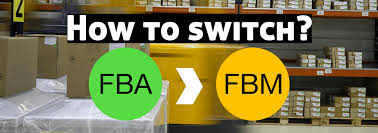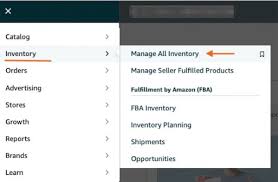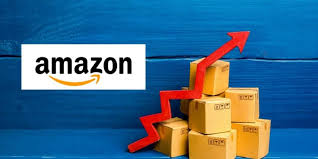
Are you wondering how to manage your Amazon orders? Switching from Amazon FBA to FBM as such, should you do it?
Switching from FBA (Fulfillment by Amazon) to FBM ( Fulfillment by Merchant) means taking control of your inventory, shipping, and customer service. This shifts can save costs and give you more flexibility, however it requires careful planning.
In this way I laydown jointly this with detail and step-by-step guideline about how to switch from FBA to FBM for Amazon Sellers.
Let’s explain in this blog about switching from Fulfillment by Amazon (FBA) to Fulfillment by Merchant (FBM) with complete guideline in-depth.
What is FBA (Fulfillment by Amazon) on Amazon?
FBA is a service where Amazon handles the storage, packaging, shipping, and customer service for sellers. When you use FBA you send your products to Amazon fulfillment centers, and they take care of the rest, including order fulfillment, returns, and customer inquiries. This permits sellers to benefits from fast shipping and Amazon logistics network, increasing chances of winning the “BUY BOX”.
However, fulfillment by Amazon comes with storage and fulfillment fees, and sellers have less control over inventory management. It is ideal for businesses looking to scale without handling logistics themselves.
What is FBM (Fulfillment by Merchant) on Amazon?
Fulfillment by Merchant (FBM) is a fulfillment method where the seller takes the responsibility for storing, packing, shipping, and handling customer service for their products. Unlike FBA, where Amazon handle all fulfillment tasks, FBM gives sellers complete control over their inventory and shipping processes. Sellers list their products on Amazon but fulfill orders themselves or through a third-party logistics provider.
This method usually results in “Lower fees” compare to FBA, but needs more hand-on effort for managing logistics, shipping, and customer support. Fbm can be a good option for sellers with specific shipping capabilities or those wanting to avoid FBA fees.
Fulfillment by Amazon (FBA) versus Fulfillment by Merchant (FBM)
FBA and FBA are two separate fulfillment methods on Amazon. With FBA, Amazon takes care of storage. packing, shipping and customer service, creating this easy and ideal for those sellers who wants a hands-off approach and get benefits of Amazon Prime eligibility.
However, Fulfillment by Merchant (FBM) comes with inventory and shipping fees, and sellers have less control over their inventory or storage.
In contrast, FBM gives sellers full control over their inventory and shipping processes, which can reduce costs but requires more management, for shipping, packaging and customer services.
Ultimately, the selection between FBA and FBM depends on a sellers performance for control, costs, and operational capabilities.
How to Switch from FBA to FBM (step-by-step guide)
Switching from FBA to FBM is easy, and give you more control, but it also comes with its challenges.
In the below, how you can make the switch from Fulfillment by Amazon to Fulfillment by Merchant:
Step 1. Analyze Your Current FBA Inventory
Before making the switch from Fulfillment by Amazon to Fulfillment by Merchant, check how much inventory is currently stored in Amazon warehouses.
Identify which products you want to switch to FBM.
At this point, you have three options for your remaining FBA inventory:
- Let it Sell out Naturally: Continue selling your existing FBA stock while starting FBM for new stock.
- Request a Removal Order: Have Amazon return your inventory to your warehouse or storage facility.
- Liquidate Inventory: If you do not want to store the products yourself, you can let Amazon liquidate them at a discount.
Step 2: Convert Your FBA Listing to FBM

Now, you need to switch your products fulfillment method from FBA to FBM. You can either convert an existing listing or create a new FBM listing while keeping your FBA listing active.
1 Option: Convert an Existing Listing from FBA to FBM
Go to Seller Central and navigate to “Manage Inventory.”
Search the product you want to switch.
Click “Edit” next to the product.
2 Option: Create a New FBM Listing (While Keeping FBA Active)
Note: If you want to sell the same product using FBA and FBM, by clicking “Add a Product” enter the ASIN and select “I will ship this item myself (FBM).” and Click “Save and Finish.”
Step 3. Set Up Your FBM Shipping Process
Since you will now handle shipment, you need a reliable system in place. Here’s what you should prepare:
- Storage Space & Inventory Management: Search a source and organized place to store your products. If your inventory is large, consider renting a warehouse or using a third-party fulfillment service.
- Packaging Materials: Amazon has strict packing requirements. Ensure you have, boxes of different sizes, shipping labels and tape, bubble wrap and a printer for invoice and labels.
- Shipping Carrier Selection: Select which carrier you will use:
Amazon Buy Shipping (for discounted rates and tracking)
USPS, UPS, FedEx, or DHL (depending on speed & cost)
Third-Party Logistics (if you want someone else to handle fulfillment)
Step 4. Configure Shipping Settings in Amazon Seller Central

You need to tell Amazon how you will ship orders to customer.
Shipping Setting Access: Go to Seller Central than go to “Setting” and choose “Shipping Setting.”
Set Handling Time & Shipping Rates: Amazon requires sellers to ship orders quickly. Set an accurate handling time. Minimum handling times are liked by customers.
Tip: If you can provide fast reliable shipping, you may qualify for Seller-Fulfilled Prime (SEP) in the future, which offers Prime advantages without using FBA.
Step 5. Analyze Performance & Adjust Pricing
After switching to FBA to FBM, closely monitor your performance to ensure smooth operations. Keep an eye on:
- Order Defect Rate (ODR): Must be below 1% to avoid account suspension.
- Late shipment Rate: Should stay under 4% to maintain good standing.
- Cancellation Rate: Must be below 2.5% to prevent penalties.
Price Strategy: FBM does not have FBA fees, so you may be able to reduce your product price and stay competitive. Also, consider offering free shipping to attract buyers.
Step 6. Customer Service and Return Policy
Being a FBM seller, now you are some responsibilities for customer service and handling returns:
Stay update with Customer: By customer inquires quickly and communication with good manners is the key of sustaining customer and for customer feedback rating.
Manage Return Policy: Your return policy should be clear and for returns you must have a clear and easy process.
Who should switch from Fulfillment by Amazon to Fulfillment by Merchant?
Below is key information about who should switch from FBA to FBM:
- Sellers with high storage fees due to long-term inventory at Amazon fulfillment centers.
- Businesses with low-margin products that become unprofitable due to FBA fees.
- Sellers who want more control over their inventory, packaging, and shipping process.
- Those with unique or fragile products that requires special handling.
- Businesses with their own efficient fulfillment system or access to third-party logistics.
- Sellers who face FBA storage limits and want to expend inventory management flexibility.
- Merchants looking to avoid Amazon strict returns polices and handle customer service directly.
- Sellers operating in niche markets where customized packaging or branding is important.
- Businesses affected by delay in Amazon shipment process, leading to stockouts or slow shipping.
- Sellers who want to offer multi-channel fulfillment such as selling on eBay, Shopify, or Walmart alongside Amazon.
Who should not switch from Fulfillment by Amazon to Fulfillment by Merchant?
- Sellers who rely on Amazon Prime eligibility to attract more customers and boost sales.
- Businesses that lack the resources to mange storage, shipping and packaging efficiently.
- Those who do not have a reliable logistics system or access to third-party fulfillment services.
- Sellers who want to minimize workload and avoid handling customer service and returns.
- Businesses that sell high-volume products and advantage from Amazon fast and cost-effective shipping.
- Those who prefer Amazon customer support managing rather than handling issues directly.
- Sellers in highly competitive niches where Prime eligibility gives an benefits over FBM listings.
- Businesses that struggle with fast shipping and might not meet Amazon delivery expectations.
- Merchants who find FBA fees manageable and prefer a hands-off fulfillment approach.
Pros and Cons of switching from FBA to FBM?
Pros of Switching from FBA to FBM
- Avoid FBA storage, fulfillment, and long-term storage fees, making it cost-effective for low-margin products.
- Manage your own stock levels, reducing the risk of Amazon restricting storage space.
- No additional FBA fees mean you keep more of your revenue, particularly for larger or heavier products.
- Easily fulfill orders from Amazon, eBay, Shopify, Walmart, and other platforms without FBA restrictions.
- Handle returns directly instead of following Amazon strict FBA returns rules.
- Ship products with branded packaging and marketing inserts to increase customer experience.
- Ideal for sellers who want to store more inventory than Amazon allows in FBA.
- Avoid delays in restocking caused by Amazon fulfillment center backlogs.
Cons of Switching from FBA to FBM
- FBM listing do not get the Prime badge, which can lower sales.
- Sellers must handle storage, packaging, shipping, and customer service.
- FBA provides fast, reliable Prime shipping, whereas FBM depends on your logistics.
- You must handle refunds, returns, and buyers inquiries yourself.
- FBA sellers usually have a competitive edge in Amazon Buy Box algorithm
- Amazon discounted shipping rates in FBA may be cheaper than what FBM sellers can access.
- FBM sellers must maintain low late shipment and defect rates to avoid penalties.
Conclusion
Switching from Fulfillment by Amazon (FBA) to Fulfillment by Marchant (FBM) can be a strategic move for Amazon sellers looking to decrease fees, gain more control over their inventory, and expand their fulfillment options. However, it needs careful planning to ensure a smooth transition. Through analyzing your current FBA inventory, setting up a reliable storage and shipping, and configuring your FBA listings and shipping settings, you can successfully make the switch without losing sales.
While FBM offers lower costs and flexibility, it also comes with greater responsibility, including handling packaging, shipping, and customer service. To succeed with Fulfillment by Merchant, sellers must maintain fast shipping times, good customer services, and high performance metrics to remain competitive on Amazon. Whether Fulfillment by Amazon or Fulfillment by Merchant is the right selection depends on your business goals, resources, and ability to manage logistics efficiently.
FAQs About Switching from FBA to FBM
What is the main difference between FBA and FBM?
Key Difference Between FBA and FBM
The key difference between Fulfillment by Amazon and Fulfillment by Merchant lies in who handle storage, packaging and shipping.
With FBA, Amazon stores you products, packs orders, and ships them to customers, making it a hands-off, scalable option with faster shipping by Prime eligibility.
However, it comes with storage and fulfillment fees. In contrast, FBM requires sellers to store, pack, and ship orders themselves. giving them more control over inventory and costs but requiring more effort.
FBA is ideal for those looking for automation and convenience, while FBM suits sellers who want higher profit margins and direct order management.
Can you switch from FBM to back FBA?
Is it better to sell FBA or FBM?
Should i switch from FBA to Fbm when my FBA goes out of stock?
How does switching from FBA to FBM affect my chances of winning the Buy Box?
How will switching from FBA to FBM affect my shipping costs?
Can i do FBA and FBM at same time?
How do i change my account type on Amazon?
You can change your, Amazon Seller account Type between individual and professional by Amazon Seller Central. To upgrade or downgrade, go to Setting and than go to Account Info and Than Manage Your Selling Plan, then select the desired plan.
Upgrading to a Professional account is ideal for high-volume sellers who need bulk listing tools, advertising, and Buy Box eligibility.
Downgrading to an individual account is better for low-volume sellers but includes a $0.99 fee per sale. Change take effect immediately, but refunds for downgrading are not provided.





